Here’s a Punjabi Mango Pickle that’s authentically our family heirloom recipe and brimming with robust flavors. Essentially a mango pickle recipe is made with tangy unripe green mangoes, spices, salt and oil. This Mango Pickle or Aam Ka Achar is a recipe which is sour and makes for the tastiest accompaniment with any Indian meal because of the choicest of spices that are used to make it. So, this summertime, pick the good green mangoes, prep up and go for this pickle recipe.
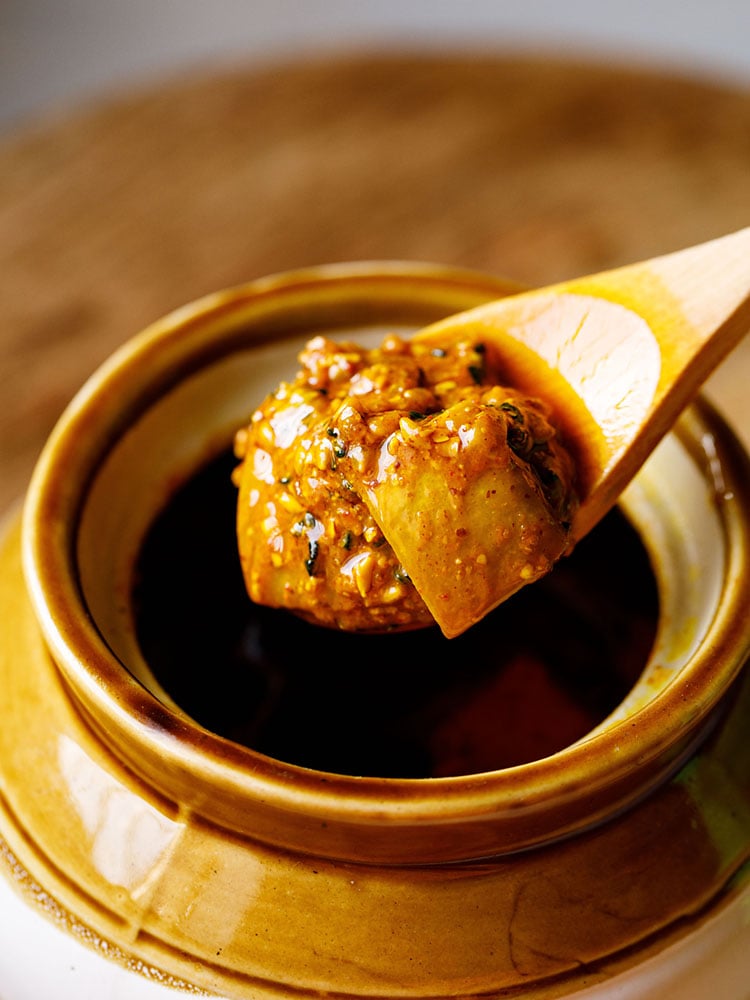
Table of Contents
India – The Pickle Nation
When one mentions India, one has to also mention about the plethora of pickles that the Indians are fond of. The Mango Pickle being one of the most loved ones, followed by Lemon Pickle, Amla Pickle, Red Chilli Pickle and other versions made with seasonal fruits and veggies.
Just like how curries or samosa is synonymous with India, so is pickles. In fact, an Indian thali (platter) is quite incomplete without a portion of pickle in it, and it can be rightly termed as one of the most favorite condiments here.
Pickles pan India are found under different monikers. For instance, ‘achaar’ in Hindi, ‘oorugai’ in Tamil, ‘loncha’ in Marathi, ‘athanu’ in Gujarati, etc. It is one of those foods that help in clearing the palate in between dishes and can elevate an otherwise boring meal.
Although the origin of the word pickle lies in the Dutch word ‘pekel’ meaning ‘brine,’ the ‘achaar’ has its origin in a Persian term meaning ‘fruits or vegetables which are salted/powdered and preserved in a solution of vinegar, salt, syrup or honey.’
About Mango Pickle Recipe
Besides being the most apt choice for parathas, dal-chawal or any other rich Indian gravy in a rice or bread combination, this Aam Ka Achar is well received not just by Indians, but also people around the world.
This is why this particular mango pickle is a sure shot hit!
- It is super easy to make. All you have to do is mix up the mango pieces with salt, spices and put it in lots of sunshine for 3 to 4 days.
- Next, you just douse good quality mustard oil and keep the jar safely in a cool, dry place for another 3 to 4 days.
- By this time, it’s ready for you to indulge in!
This Punjabi Mango Pickle recipe is my mother-in-law’s special. She had learnt it as it passed down from her mother-in-law. We Indians really take pride in such valuable recipes that are nothing less than a treasure.
There are numerous ways an Aam Ka Achar is made pan India with each pickle having a distinct flavor and method of preparation.
As you travel through our country’s length and breadth, you will find people pickling raw mangoes, in both sour and sweet versions and enjoying them with their everyday meals.
I am quite a pickle person and like to pair everything from dal, vegetable stir-fries, roti and paratha with a variety of pickles.
If you love pickles just as I do, I’m so sure that you are going to fall in love with this Mango Pickle.

How to make Mango Pickle Recipe
Prep Spices
1. Before you begin, take the spices and salt in small bowls and keep them in sunlight for 1 to 2 hours. This step is optional but does help in getting rid of any moisture from the spices and salt.
Spices added to this pickle recipe are:
- Fenugreek seeds – ¼ cup
- Fennel seeds – ¼ cup
- Mustard seeds (can use either black or yellow) – ¼ cup
- Nigella seeds (kalonji) – ¼ cup
- Turmeric powder (ground turmeric) – 3 tablespoons
- Red chili powder or cayenne pepper – ¼ cup
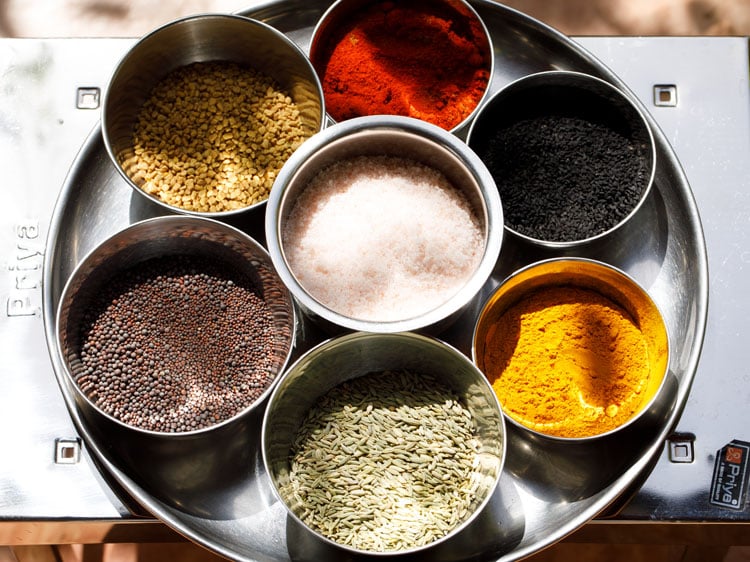
2. Later, take the fenugreek seeds and mustard seeds in a dry grinder jar or a spice-grinder.
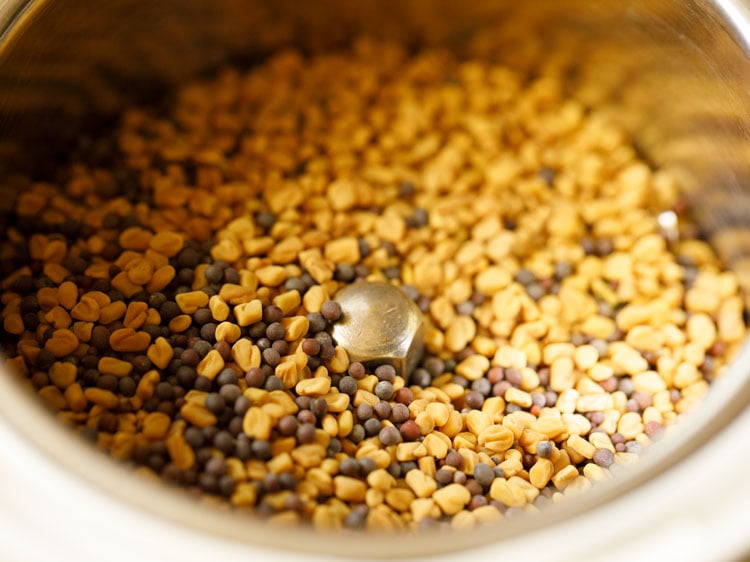
3. Grind to a coarse mixture. Do not make a fine powder.

Prep Mangoes
4. Rinse and wipe the raw mangoes well with a clean kitchen towel. You can even let the mangoes dry naturally.
In the photo you only see two mangoes as they were very large mangoes weighing 1 kilogram together.

5. Chop the mangoes into 1.5 inches pieces. Discard the stones but do peel off the flesh from the stones, if any.
No need to remove the outer skin of the mangoes if they are tender and soft. You will need 7 to 7.5 cups chopped mangoes.
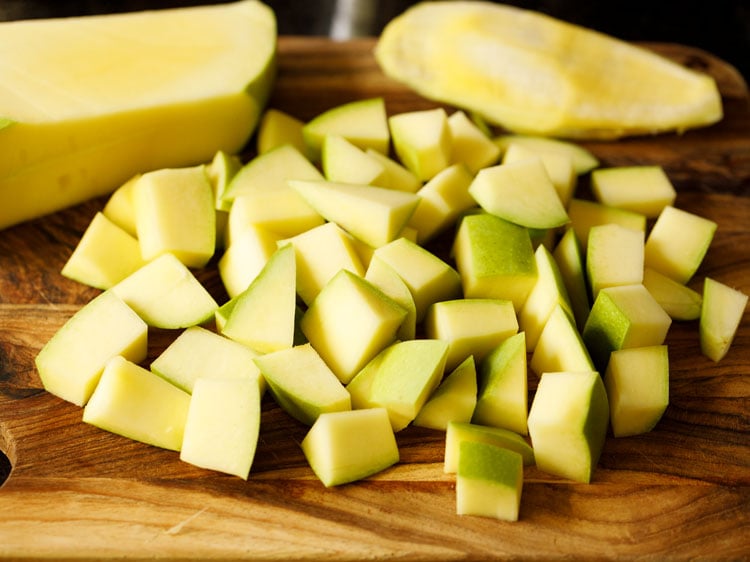
6. Take the chopped mangoes in a large mixing bowl. Better to use a steel or a glass bowl as they are non-reactive.
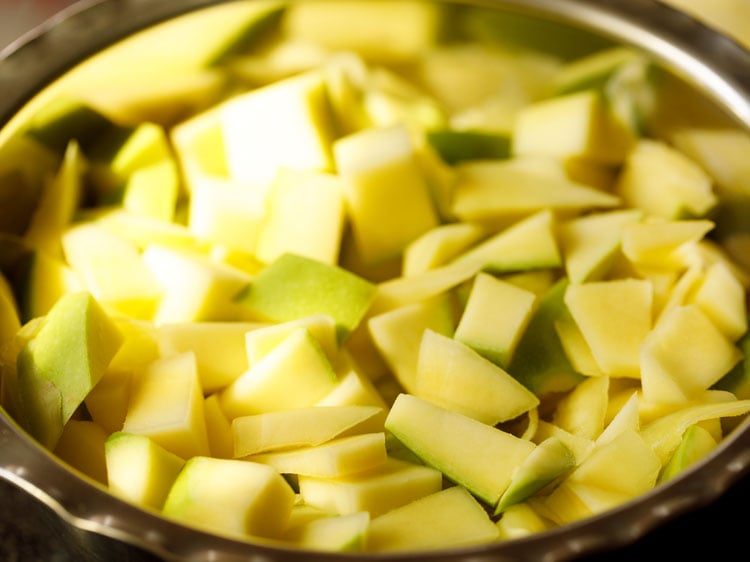
Make Pickle Mixture
7. Now firstly, add the ground fenugreek seeds and mustard seeds.

8. Then, add the remaining spices – fennel seeds, nigella seeds, turmeric powder and red chili powder or cayenne pepper.
I have added two types of red chili powder – Kashmiri red chili powder (for color) and a spicy red chili powder.
You can use even just one type of red chili powder or even a mix of cayenne pepper and paprika.
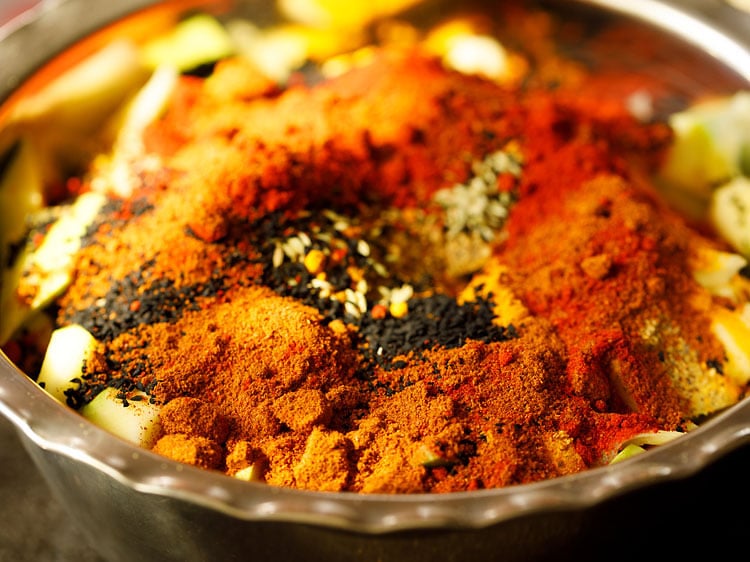
9. Next, add salt.

10. With a steel or wooden spoon, mix very well so that the spices uniformly coat the mango pieces.
Check the taste of the pickle masala mixture or 1 to 2 mango pieces. The taste should be slightly salty. If not, then add more salt.

11. Now, pour ½ cup mustard oil.
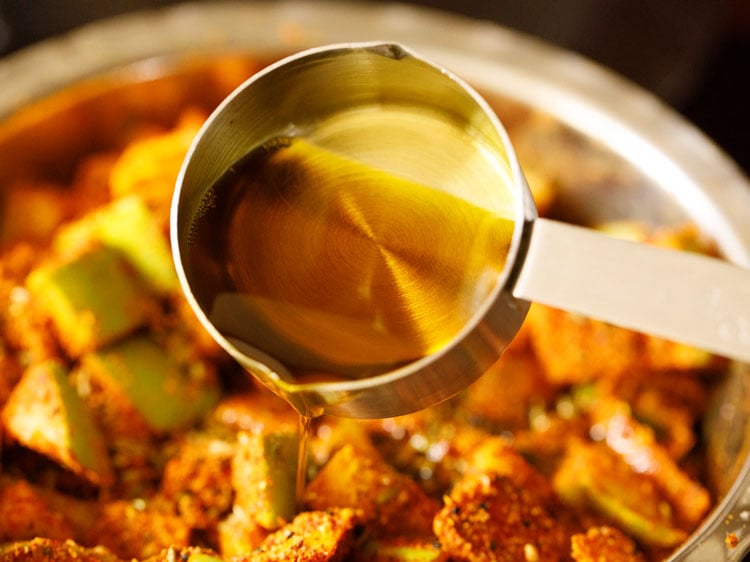
12. Mix very well.
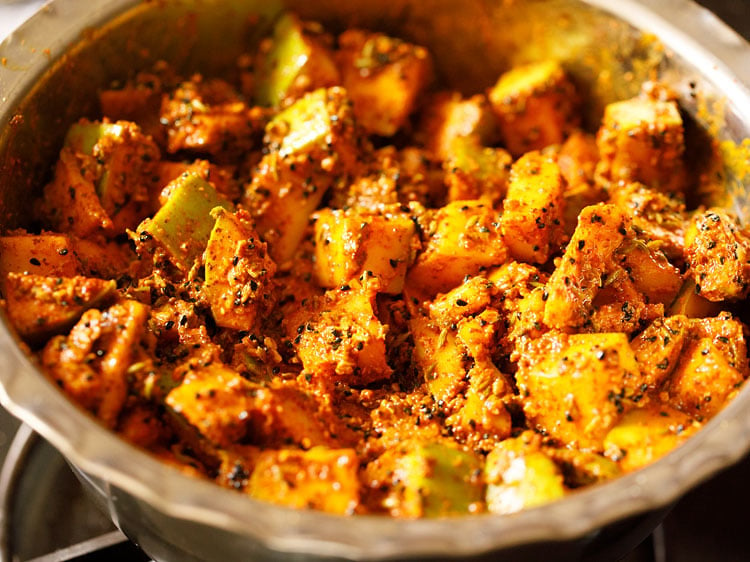
13. Spoon the prepared pickle mixture in a clean ceramic jar or glass jar. Use a clean spoon.
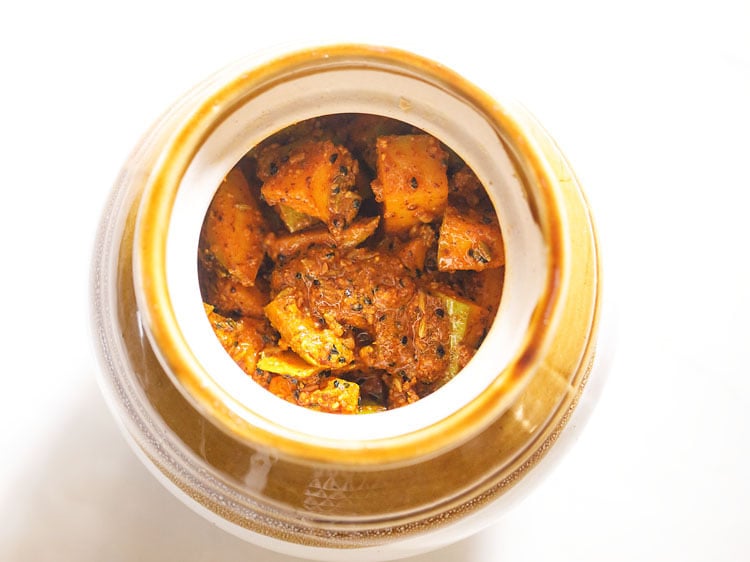
Sun Dry Mango Pickle
14. Seal with a lid and keep in sunlight for 3 to 4 days. I used two jars. Note that the sunlight should be very good with strong sun rays falling on the pickle jar.
It should not be cloudy or dark. In the evening, get the jar inside and keep in a cool dry place. Next morning, keep in sunlight again.
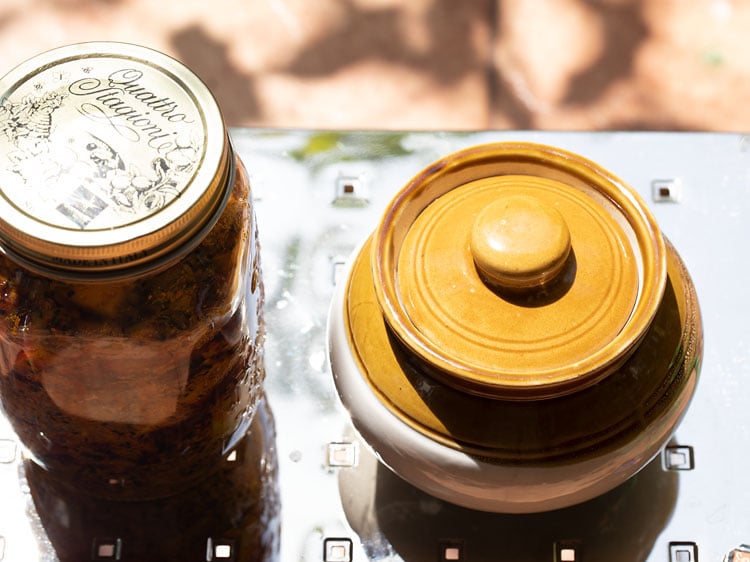
15. Everyday after sun-drying in the evening, open the lid and give a gentle mix to the pickle with a clean spoon.
This is the pickle being mixed on the first day. Take the mango pieces settled at the bottom upwards in the jar and give a thorough mix. Basically, mixing and tossing needs to be done everyday.
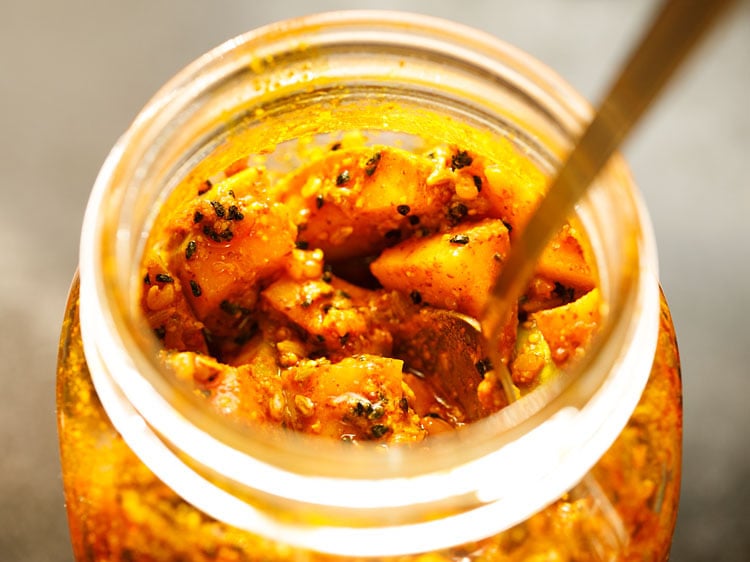
16. The below photo is of the pickle on the third day. You can see the oil floating.

17. The pickle after mixing on the fourth day.
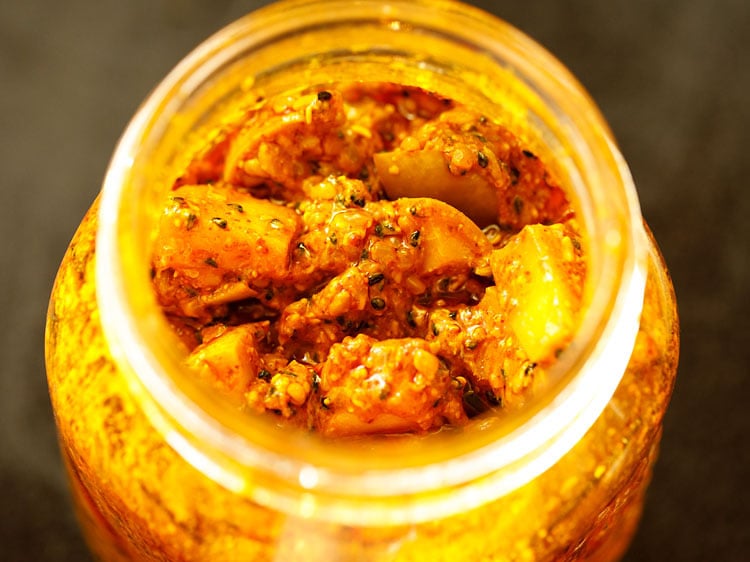
18. On the last day, pour 2.5 cups of mustard oil in the jar.

19. Again with a clean spoon give a thorough mix. The oil should seep inside and reach the bottom of the jar. All the mango pieces should be surrounded with some oil.
You do not need to heat the mustard oil. You can add more mustard oil if required. The mustard oil should float above the pickle by 2 to 3 inches. Always remember to keep the oil floating above the pickle.
Seal with a lid and keep in a cool dry place for 4 days until everything gets mellowed and pickled.
Initially, you may find a slight bitter taste in the pickle, but after 6 to 7 days, the bitterness will go away.

20. Enjoy the Mango Pickle or Aam ka Achar with any Indian meal. The pickle stays good for more than a year at room temperature without refrigeration. Keep the jar in a cool dry place.
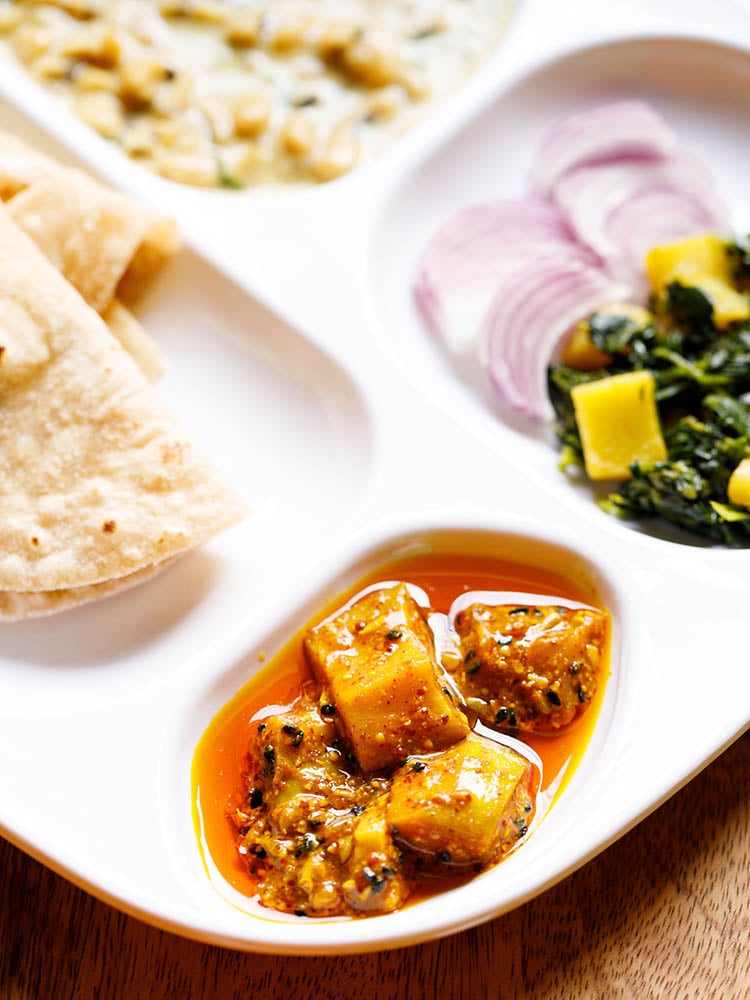
Serving Suggestions
Remember to store the pickle jar in a cool dry place. To serve, I would suggest to take a small portion of the pickle for a week or 15 days in smaller jars or bowls. Keep this jar or bowl on your dining table, kitchen or in the fridge.
While taking the pickle from the jars, always use a clean dry spoon. Make sure there is no water or moisture on the spoon as this can spoil your pickle.
In North India, apart from the usual way of consuming the Mango Pickle with meals, it is also served with flatbreads like Aloo Paratha, Paneer Paratha or any other paratha for that matter.
One of the most favorite childhood memories of ours includes we taking parathas with Aam Ka Achar in our lunch box.
When speaking of being a side condiment, the Mango Pickle tastes excellent with some rice-lentils, Curd Rice or other curries with rice.
This Punjabi Mango Pickle can also easily elevate a simple meal of even chapati or roti with any vegetable dish. Otherwise, mix the pickle masala with steamed rice and enjoy a simple and comforting, yet heavenly meal.
And while you lose yourself to the awesomeness of the sour Mango Pickle, this Avakaya Pickle is another recipe that you must try till the mango season lasts.
Make Pickle Without Sunlight
While it is absolutely paramount to have sunlight to make any traditional pickle, I have worked on a Punjabi Mango Pickle recipe that can be made sans the sun too.
You simply have to mix everything and pour it in a jar. But, do these before:
- Heat mustard oil till it smokes, and then cool it to room temperature. Add to the spiced mango pieces mixture.
- Make it a practice to cover this pickle with 2 to 3 inches layer of mustard oil on top in the jar.
- Close the lid of the jars tightly. Keep the jars in a dry place for about 5 to 6 days or more until the mangoes soften and tenderize.
- Do remember to stir the pickle with a dry and clean spoon once every day. Cover the jar again with a lid and continue to store it in a dry place until the pickle is ready.
Expert Tips
- Get raw mangoes with tender skin and use without peeling the skin. In case the mangoes have tough skin, then peel and use.
- Make sure to always use fresh spices. Take them on a plate and then discard the husks and stones, if any.
- Grind the mustard and fenugreek seeds coarsely for this pickle. You can also use store-brought split mustard and fenugreek seeds.
- You can add more or less red chili powder depending upon the level of spiciness you want in the pickle.
- The jar used to store the mango pickle should be thoroughly sterilized, cleaned and dried. Preferably use a glass jar or ceramic jar. Do not use plastic jars.
- Keep in mind the hygiene and cleanliness while making any pickle, jam, sauce, preserve or for that matter any food.
- This Aam Ka Achar recipe can be scaled accordingly.
FAQs
I would suggest not to store this mango pickle in a plastic jar. Try to use a ceramic jar or a good sturdy glass jar.
This mango pickle will stay good for more than a year. Even if the pickle is not sun-dried or partially sun-dried, it stays good for more than a year. Cover the pickle with a generous layer of oil as well to keep it good.
One way to soften the mangoes is just heating through, but not boil. Once the pickle is hot, let it cool on its own and don’t cover with a lid. However, you can cover with a pan, cotton napkin or muslin cloth. Make sure the water doesn’t condense as this might spoil the pickle.
Choose mangoes that are raw, firm and a dark green in color with a white-colored flesh. If the flesh is yellow, it means the mango is slightly ripe.
Store this pickle in a ceramic jar by putting a muslin cloth on the mouth, later securing it with a string and then putting the lid.
Use either. Both work well in this pickle recipe.
Moisture in the pickle will result in fungus. Avoid this by covering the pickle with a thick layer of oil and keeping it dry. Any mould or fungus means you have to discard the entire pickle and there is nothing you can do to rectify it.
You can prepare this pickle with sesame oil or sunflower oil.
Preferably, the pickle has to be sun-dried. If not, then it can be dried under the fan too. But this will reduce the shelf-life as otherwise sun rays kill microorganisms.
You needn’t discard the water as it gets evaporated while the pickle is sun-dried.
More Indian Pickle Recipes To Try!
Pickle Recipes
Pickle Recipes
Pickle Recipes
Pickle Recipes
Please be sure to rate the recipe in the recipe card or leave a comment below if you have made it. For more vegetarian inspirations, Sign Up for my emails or follow me on Instagram, Youtube, Facebook, Pinterest or Twitter.
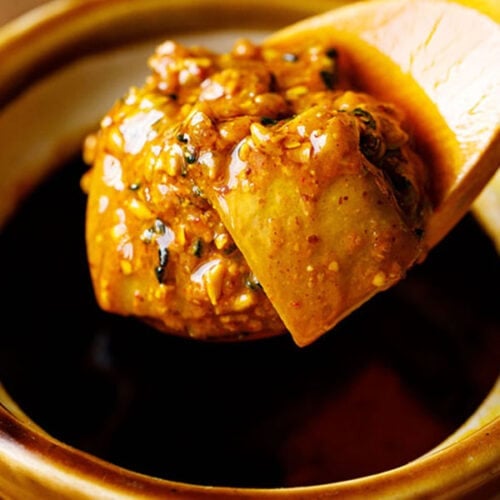
Mango Pickle | Punjabi Aam ka Achar Recipe
Ingredients
- 1 kilogram mangoes or 7 to 7.5 cups of chopped mangoes – unripe and green
- ¼ cup mustard seeds – 40 grams, black or yellow or 40 grams split yellow mustard seeds
- ¼ cup fenugreek seeds – 45 grams or 45 grams split fenugreek seeds
- ¼ cup fennel seeds – 30 grams
- ¼ cup nigella seeds (kalonji) – 30 grams
- 3 tablespoons turmeric powder (ground turmeric) – 15 grams
- ¼ cup red chili powder or cayenne pepper – 25 grams
- ½ cup rock salt (edible and food grade) – 125 grams or add as required – can also add regular salt or pink salt
- 3 cups mustard oil – add more if required
Instructions
Prep Spices and Mangoes
- Before you begin, take the spices and salt in small bowls and keep them in sunlight for 1 to 2 hours. This step is optional but does help in getting rid of any moisture from the spices and salt.
- Later, take the fenugreek seeds and mustard seeds in a dry grinder jar or a spice-grinder and grind to a coarse mixture.
- Rinse and wipe the raw mangoes and let them dry naturally. You can even wipe them dry with a clean kitchen towel.
Making Mango Pickle
- Chop the mangoes into 1.5 inches pieces. and add them in a bowl. Discard the stones but do peel off the flesh from the stones, if any. No need to remove the outer skin of the mangoes if they are soft and tender.
- Take the chopped mangoes in a large non-reactive mixing bowl.
- Now begin by adding the ground fenugreek seeds and mustard seeds first.
- Then, add fennel seeds, nigella seeds or onion seeds, turmeric powder, red chili powder and salt.
- With a steel or wooden spoon, mix very well so that the spices uniformly coat the mango pieces. Check the taste of the pickle masala mixture or 1 to 2 mango pieces. The taste should be slightly salty. If not, then add some more salt.
- Next pour ½ cup mustard oil.
- Mix very well.
- Spoon the prepared pickle mixture in a clean ceramic jar or glass jar. Use a clean spoon.
- Cover with a lid and keep in sunlight for 3 to 4 days. Note that the sunlight should be very good with the strong rays falling on the pickle jar. It should not be cloudy or dark.
- Everyday after sun-drying in the evening, open the lid and give a gentle mix to the pickle with a clean spoon. Take the mango pieces settled at the bottom upwards in the jar and give a thorough mix. Basically, mixing and tossing needs to be done everyday.
- In the evening, get the jar inside and keep in a cool dry place. Next morning, keep in the sunlight again.
- After keeping in sunlight for 3 to 4 days, add the remaining 2.5 cups mustard oil. Again with a clean spoon, mix very well. The oil should seep inside and reach the bottom of the jar. All the mango pieces should be surrounded with some oil.
- Note that you do not need to heat the mustard oil. You can add more mustard oil if required. Do keep in mind that the mustard oil should float above the pickle by 2 to 3 inches. Always remember to keep the oil floating above the pickle.
- Seal with a lid, keep in a cool dry place for 4 days till everything gets mellowed and pickled.
- Initially, you may find a slight bitter taste in the pickle, but after 6 to 7 days, the bitterness will go away. This Mango Pickle stays good for more than a year at room temperature without refrigeration.
- Enjoy this Punjabi Mango Pickle with any Indian meal.
Notes
- Make sure the spices are within their shelf period and have not gone rancid.
- Use good quality mustard oil and preferably cold pressed or wood pressed.
- Instead of mustard oil, you can use sesame oil (made from raw sesame seeds) and sunflower oil. But keep in mind that the taste and flavor of the mango pickle made with either of these oils will be different.
- Note that the approximate nutrition info is for the entire jar of Mango Pickle.
Nutrition Info (Approximate Values)
This Mango Pickle recipe post from the archives first published on May 2012 has been updated and republished on April 2023.
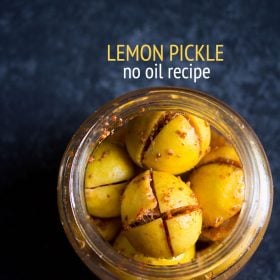
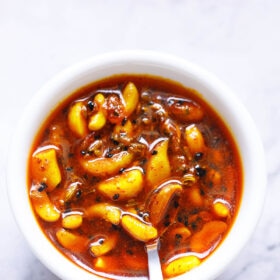
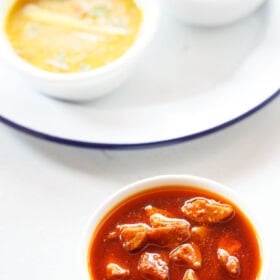



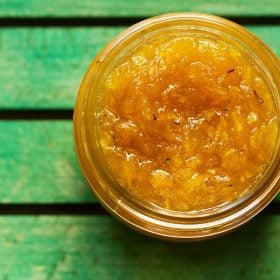








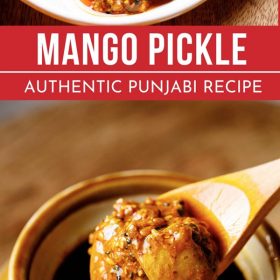
Can I add vinegar before I add the mustard oil or along with it, and what would be the proportion
there is no vinegar added in this pickle recipe. there is no need. just cover the pickle with a layer of mustard oil.
thanks a lot for all your wonderful delicious recipes. I have tried out many. I just want to know that it is compulsory to put mustard oil in mango pickle. as i like dry pickle more.
and i want to try it soon..
welcome rashi. traditionally mustard oil is added. but you can add sesame oil or peanut oil.
really really good and yummy. i love this.
thanks nisha
hi…plz post lemon pickle as well. Your mango pickle looks awsome. Will try soon 🙂
thanks priya. i have noted down the recipe request and will try to add it soon.
Thanks you for posting such a fabulous recipe. I am in the drying process at the moment. I think the answer is obvious but I will ask anyway. I am up to the third day now and moisture is building up at the bottom of the containers that the mango pieces are drying in. Am I supposed to drain this liquid, discard it and keep drying out the mangoes?
welcome. for even drying do turn the mango pieces everyday with a clean spoon so that all of them ate dried evenly and uniformly. ideally you should not get moisture. i think the light is not reaching the bottom and hence the moisture. discard this liquid. better to dry in a large tray or plate. this way all the mango peices will get even sunlight. place all of them in a large tray or plate and keep in the sun for drying. you can easily dry upto a week also.
Easy to learn
hi, can i use olive oil instead of mustard oil? this recipe looks amazing!
muneet, you can use sesame oil or sunflower oil. i won’t suggest olive oil.
this is n nice recipie
thanks rudolf
this pickle look so nice, I would love to have more recipies . thanks a lot. rudi
welcome rudi
I want to product mango pickle for commercial purpose as cottage industry. so, kindly tell me about all machinary used for preparation mango pickle and also tell me from where i can purchase that all machinary .
sanjay, we don’t have any knowledge or experience in this field.
Hi, since the sky has been cloudy, cannot keep the mangoes i the sun, can i dry it under the fan??
savita, you have to preferably keep it in the sun. if there is no option then keep in a dry place or under fan. but shelf life might reduce. as sun rays kills microorganism.
other better option sis – just mix everything and pour the mixed mango-spice powders in a jar. in this case you heat the mustard oil till it start smoking and then when it become cool, you add it to the spiced mango pieces. cover with a 1 inch layer of mustard oil. always keep the mango pickle covered with a layer of mustard oil. store mango pickle in a dry place for 2-3 days. but there will be moisture in the mango pieces as they are not dried in sun.
Hi….I am liking the way u have made the aam ka achar but I don’t know why its getting fungus when I am keeping it in sun after adding masalas.I have tried it for the 2nd time.
if you keep in the sun, fungus should not come. the sunlight won’t allow the fungus to come. are the spices fresh and within their shelf life date. if the spices shelf life date is expired, then there might be issues of mould growing on the pickle.
I have made the pickle bt now I have tasted it and it has less salt.what should be done? if I add salt then it will drain water in the jar.
have you added the oil. if you have added the oil, then add the salt and stir very well with a clean spoon.
Hi,
Thanks for your recipe. I did try it, but I think I over dried the mango and also the pickle has very less masala. Any suggestions how I can rectify it? Or would I need to discard it 🙁
welcome hazel. i don’t know that you can do now for over dried mangoes. if you want to spice it up little just add some chillii powder from top and mix well. don’t add any other spices because mustard and other spices they age and thats what gives flavor to the pickle.
after I prepared the pickle only, I realized that salt is not sufficient.. so can I add after oil is poured into the jar.. will it spoil the pickle??
you can add. it won’t spoil the pickle. just add the salt and shake the jar.